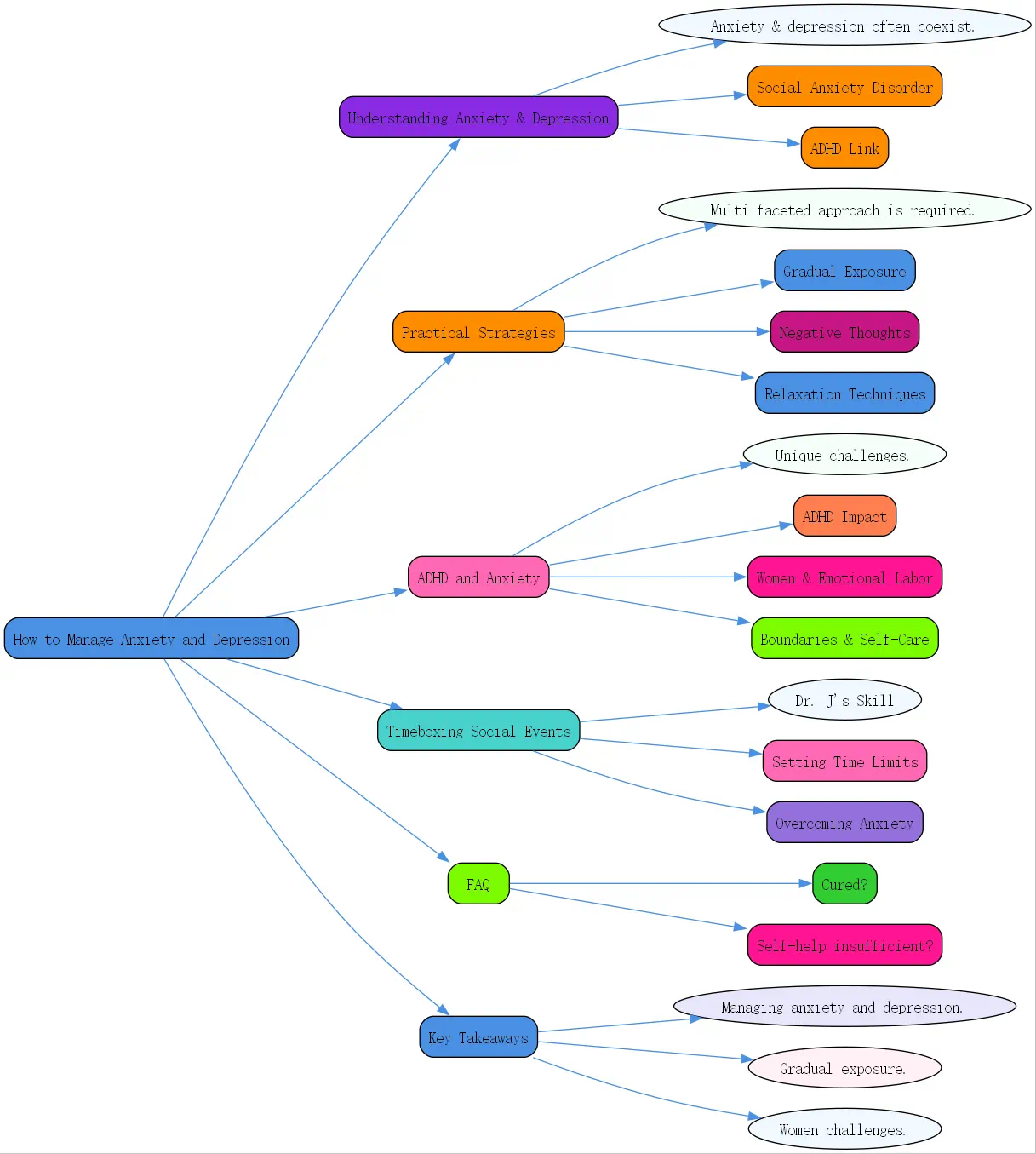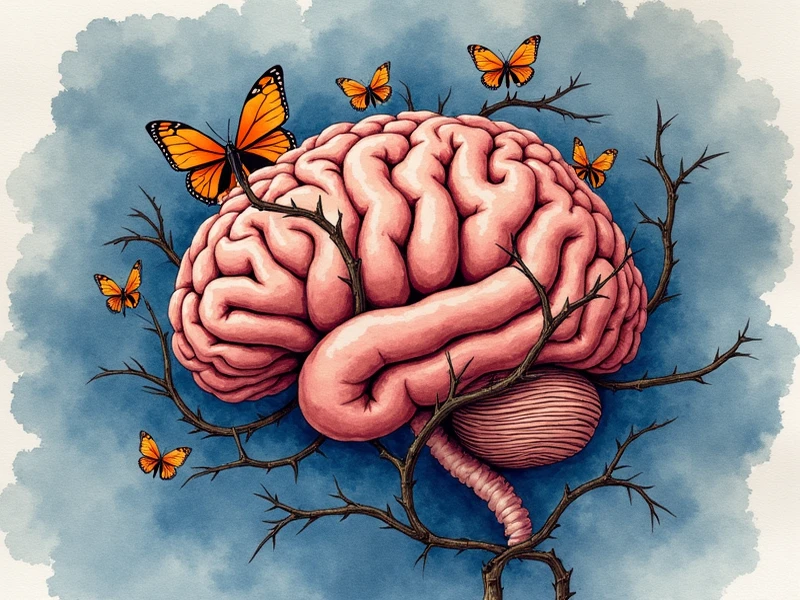Understanding Anxiety and Depression

Anxiety and depression often coexist, creating a challenging mental health landscape that affects millions worldwide. For many individuals, especially those with ADHD, these conditions can significantly impact daily functioning and quality of life. At BrainTalking, we recognize the importance of understanding these conditions as the first step toward effective management.
Defining Social Anxiety Disorder
Social anxiety disorder involves an intense fear of being judged, embarrassed, or rejected in social situations. Unlike occasional nervousness, this disorder is characterized by persistent fear that can be debilitating. The diagnostic criteria include:
- Intense fear or anxiety about social situations, such as meeting new people, presenting to groups, or eating in public
- Consistent anxiety triggered by these social encounters
- Avoidance of social situations or enduring them with significant discomfort
- Fear disproportionate to the actual situation
- Persistence of symptoms for six months or longer
- Interference with daily functioning in work, home, or relationships
- Symptoms not attributable to other medical conditions, medications, or mental health disorders
Understanding these criteria helps differentiate between clinical social anxiety disorder and normal social nervousness, which is crucial for proper treatment approaches.
The Difference Between Normal Social Anxiety and Social Anxiety Disorder
It’s important to recognize that a certain level of social anxiety is not only normal but adaptive. As social creatures, humans naturally experience some anxiety in novel situations or when interacting with unfamiliar people. This healthy stress response helps us navigate social environments effectively.

The key distinction lies in intensity and impact. Normal social anxiety might cause temporary discomfort but doesn’t prevent participation in social activities. Clinical social anxiety disorder, however, is paralyzing and significantly disrupts daily functioning.
Self-diagnosis can be problematic because many people experience some degree of anxiety. What makes something a clinical concern rather than an everyday challenge often requires professional assessment. Unless social interactions cause extreme reactions (like vomiting from fear), consulting with a mental health professional is essential for accurate diagnosis.
The Link Between ADHD and Social Anxiety
Research shows a correlation between ADHD and social anxiety, particularly among those with predominantly inattentive ADHD. Several factors contribute to this connection:
Negative self-talk often develops from ADHD-related social challenges, leading to feelings of inadequacy that fuel anxiety. Executive function difficulties鈥攅ssential for maintaining relationships鈥攃an create stress around social obligations. Planning hangouts, remembering to respond to messages, and keeping track of important dates all require executive skills that may be compromised in ADHD.
Additionally, impulsivity or mood-dependent behaviors can lead to inconsistent social reliability. If you have a history of canceling plans at the last minute due to overwhelming feelings or changing moods, this pattern can generate anxiety about future social commitments.
Tips to Manage Stress and Anxiety: Practical Strategies
Learning how to manage anxiety and depression effectively requires a multi-faceted approach. The following evidence-based strategies can help address both conditions while promoting overall mental wellbeing.
Gradual Exposure: A Step-by-Step Approach
Gradual exposure involves systematically facing anxiety-provoking situations in a controlled, incremental manner. This technique helps desensitize your nervous system to anxiety triggers over time.
Consider Emma’s example: She experienced significant anxiety when talking to strangers. Instead of avoiding all social interaction, she started with small steps鈥攕imply saying hello to cashiers at the grocery store. Once comfortable with this level of interaction, she progressed to asking cashiers about their day. Eventually, she built enough confidence to engage with coworkers at social events.
The key to successful gradual exposure is starting with situations that cause mild anxiety and slowly working toward more challenging scenarios. This approach prevents overwhelming your system while building confidence and resilience.
Challenging Negative Thoughts and Cognitive Restructuring
Social anxiety and depression often involve negative or catastrophic thinking patterns. Thoughts like “”Everyone will think I’m stupid”” or “”I’ll definitely embarrass myself”” can feel factual but are typically distortions.

Jennifer, who worried about embarrassing herself during team presentations, learned to challenge these thoughts by asking:
- What evidence supports this belief?
- Have I successfully given presentations before?
- What’s the worst that could realistically happen?
- What’s a more balanced perspective?
This cognitive restructuring process helps identify and modify unhelpful thought patterns that fuel anxiety and depression. By examining the evidence for and against negative thoughts, you can develop more realistic and balanced perspectives.
Relaxation Techniques: Breathing Exercises and Mindfulness for Anxiety Relief
Physical symptoms of anxiety鈥攔acing heart, shallow breathing, muscle tension鈥攃an be effectively managed through relaxation techniques. These practices help activate the parasympathetic nervous system, countering the fight-or-flight response.
Marisol’s example illustrates this approach. Before attending social events, she would notice physical anxiety symptoms like an elevated heart rate and shaking hands. She implemented the 4-7-8 breathing technique (inhale for 4 seconds, hold for 7, exhale for 8) to calm her nervous system. Throughout events, she would periodically check in with her body to remain grounded.
Other effective relaxation techniques include progressive muscle relaxation, mindfulness meditation, and body scanning. Regular practice of these methods can reduce baseline anxiety levels and provide tools for managing acute anxiety episodes.
How to Manage ADHD and Anxiety: Specific Considerations
The intersection of ADHD and anxiety presents unique challenges that require targeted strategies. Understanding these connections can help develop more effective management approaches.
The Impact of ADHD on Social Interactions
ADHD can significantly affect social functioning through various mechanisms. Difficulty maintaining attention during conversations, interrupting others due to impulsivity, or missing social cues can create awkward interactions that feed anxiety.
Executive function challenges may make it difficult to remember plans, arrive on time, or follow through on social commitments. These patterns can lead to relationship strain and reinforce negative self-perception, creating a cycle of social anxiety.
For those wondering how to manage ADHD and anxiety together, integrated treatment approaches that address both conditions simultaneously often yield the best results. This might include medication management, cognitive-behavioral therapy, and specific skill-building exercises.
Societal Expectations and Emotional Labor in Women with ADHD
Women with ADHD face additional challenges due to societal expectations. They’re often expected to be polite, accommodating, and emotionally supportive while maintaining perfect appearances鈥攅xpectations that can be particularly difficult with ADHD.
One patient described maintaining impeccable appearance standards (regular blowouts, manicures, perfect makeup) during a difficult breakup because she felt pressured to “”keep up appearances.”” Women are frequently expected to provide emotional labor in relationships鈥攕upporting partners, friends, and family鈥攚hile struggling to create space for their own needs.
These gendered expectations create additional pressure for women with ADHD, who may already struggle with organization, time management, and emotional regulation. The resulting stress can exacerbate both anxiety and depression symptoms.
Strategies for Women: Setting Boundaries and Self-Care
For women navigating ADHD and anxiety, establishing healthy boundaries is essential. This includes:
- Learning to say no to additional responsibilities when overwhelmed
- Communicating needs clearly to partners, friends, and family
- Prioritizing self-care activities that support mental health
- Challenging perfectionist standards and embracing “”good enough””
- Creating systems that support executive functioning challenges
With professional guidance, women can develop these skills while addressing both ADHD symptoms and anxiety. Over time, setting appropriate boundaries creates space for healing without completely disengaging from important relationships and responsibilities.
Bonus Strategy: The Dr. J Skill – Timeboxing Social Events
One particularly effective strategy for managing social anxiety comes from Dr. J’s personal toolkit: timeboxing social events.

Setting a Time Limit to Reduce Anxiety
When facing anxiety-provoking social situations, setting a predetermined time limit can significantly reduce stress. This approach acknowledges your limitations while still allowing participation in important events.
For example, if invited to a birthday party where you know few people, commit to attending for just one hour. Knowing you have permission to leave after this time dramatically reduces anxiety because the situation feels more manageable with a defined endpoint.
Interestingly, once the pressure is removed, many people find they actually stay longer than planned. The timeboxing approach addresses the anticipatory anxiety that’s often worse than the actual experience.
Overcoming Anticipatory Anxiety with Scheduled Social Engagements
Anticipatory anxiety鈥攖he worry experienced before an event鈥攊s often more intense than the anxiety felt during the actual situation. By scheduling social engagements with clear parameters, you can reduce this pre-event stress.
The timeboxing technique works particularly well for those with ADHD and anxiety because it:
- Creates clear structure and expectations
- Prevents overwhelm and sensory overload
- Allows for necessary recovery time
- Builds confidence through successful experiences
This strategy can be combined with other techniques like gradual exposure and cognitive restructuring for even greater effectiveness. Over time, these approaches help build tolerance for social situations that once seemed overwhelming.
Frequently Asked Questions
Can anxiety and depression be completely cured?
Rather than thinking about “”curing”” anxiety and depression, it’s more accurate to focus on effective management. Many people learn to manage symptoms so well that they no longer interfere with daily life. This management typically involves a combination of therapy, possibly medication, lifestyle changes, and ongoing self-care practices.
For those with ADHD and co-occurring anxiety or depression, integrated treatment approaches that address all conditions simultaneously often yield the best results. At BrainTalking, we emphasize personalized treatment plans that consider the unique needs and circumstances of each individual.
What should I do if self-help strategies aren’t enough to manage my anxiety and depression?
If you’ve tried multiple self-help strategies for managing anxiety and depression without significant improvement, it’s important to seek professional help. A qualified mental health professional can provide proper assessment, diagnosis, and treatment recommendations.
Remember that seeking help is a sign of strength, not weakness. Many effective treatments exist for anxiety, depression, and ADHD, including therapy, medication, and combination approaches. The right treatment can significantly improve quality of life and functioning.
Key Takeaways on How to Manage Anxiety and Depression
- Understanding the difference between normal anxiety and clinical disorders is crucial for appropriate treatment
- Gradual exposure, challenging negative thoughts, and relaxation techniques are effective strategies for managing anxiety and depression
- Women with ADHD face unique challenges due to societal expectations and emotional labor demands
- Setting boundaries and practicing self-care are essential for women managing ADHD and anxiety
- Timeboxing social events can significantly reduce anticipatory anxiety
- Professional help should be sought if self-help strategies prove insufficient




